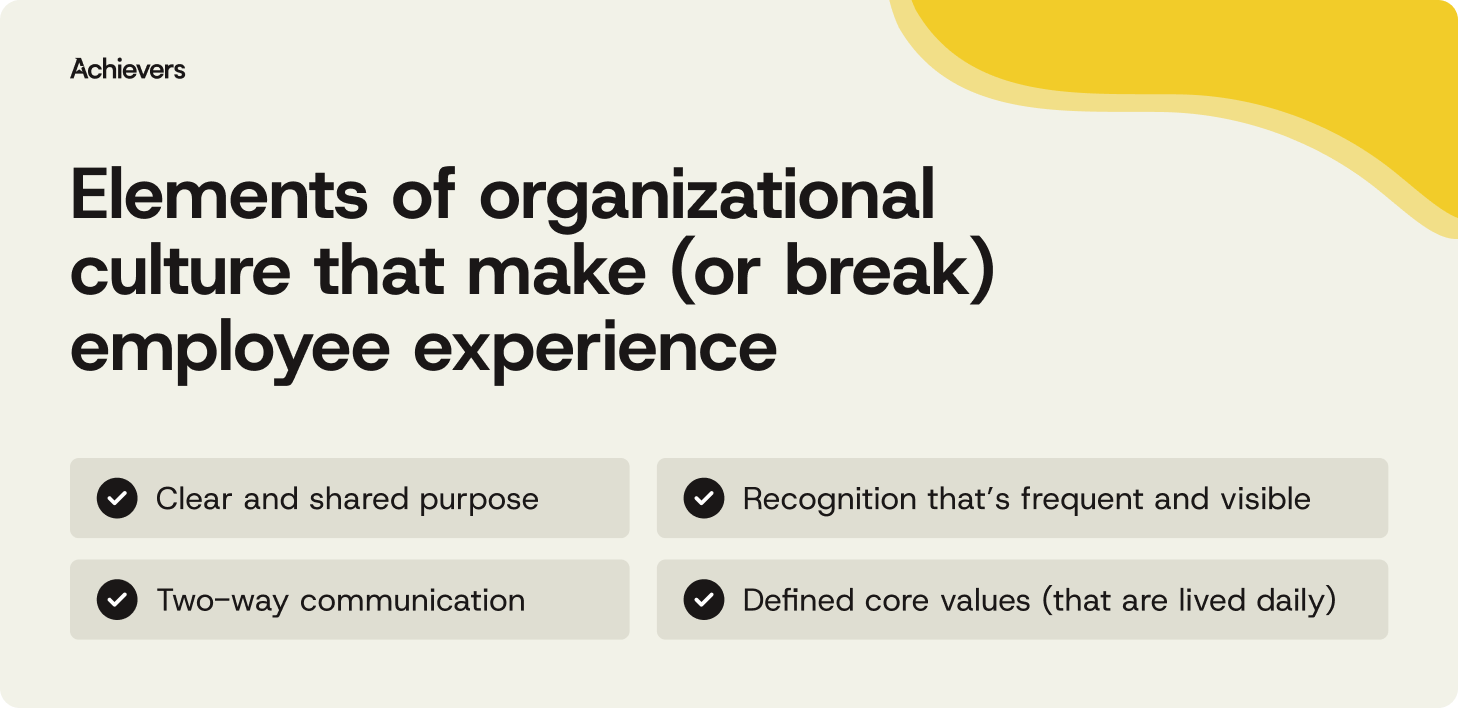Table of contents
Create a culture that means business™
Schedule a demo with an Achievers solution expert today.
Culture isn’t the foosball table in the break room, or a mission statement buried on your “About Us” page. It’s how your people experience work — every single day. And in a world of hybrid teams, shifting employee expectations, and rising pressure to engage and retain talent, culture has evolved from a “nice to have” into a business imperative.
A strong culture revolves around creating a workplace where employees feel supported, motivated, and connected. And the impact is real: 93% of engaged employees go above and beyond in their roles, compared to just 46% of those who are disengaged.
Culture shapes behavior, and behavior drives results. It’s not a side project — it’s the foundation of your organization’s performance.
The must-have elements of organizational culture for a thriving workplace
Organizational culture is everything. It’s the invisible hand that shapes how people think, behave, and show up every day. It’s how an employee feels in a team meeting, the way feedback is shared, and yes — the reason someone might stay or go.
So, let’s dive into the 10 must-have elements that create culture employees actually want to be a part of.

1. Recognition that’s frequent and visible
Recognition is the cultural superglue that holds everything together. According to Achievers Workforce Institute (AWI), 90% of employees say that receiving recognition for their work motivates them to put in more effort. When done correctly, it reinforces values, boosts morale, and encourages the behaviors you want more of.
And it’s not just about a rare shoutout in the Monday standup — recognition should be frequent, prompt, and specific. “Great job on that project” is a nice start. “Your data insights helped us pivot our Q3 strategy, thank you!” is gold. Recognition builds culture in real time and keeps it human.
2. A clear and shared purpose
No one wants to feel like a cog in a machine. Employees want to understand how their work contributes to something bigger. A shared purpose provides meaning — and it’s one of the biggest drivers of engagement. When people can connect the “what” to the “why,” their motivation skyrockets.
But here’s the catch: that purpose must be communicated consistently across every level, from interns to execs. Leaders should reinforce purpose in town halls, 1:1s, and especially through recognition. When purpose becomes part of the daily conversation, alignment becomes second nature.
3. Two-way communication
Let’s retire from the idea that communication is a top-down memo. Culture thrives when employees feel like participants and not just recipients. Two-way communication builds trust and helps people feel heard. A few great ways to do this include pulse surveys, suggestion channels, informal feedback loops — whatever works for your employees is the correct answer if the goal is to actually listen and act.
Keep in mind, companies and leaders who say “we hear you” but never follow up? That’s just noise and will only lead to negative results in the long-run.
4. Practicing defined values
Company values are usually the first thing a company writes — and the first thing to collect dust on the website or office wall. The real question is: Are you making decisions based on values, or just displaying them? Are they embedded in how you hire, lead, and recognize your people? Are leaders modeling values in their daily behavior?
Don’t panic if the answer isn’t an obvious “yes!” — make changes now. Kick off meetings with shoutouts that tie back to your values. Spotlight team wins that reflect your culture. Recognize and reward employees who embody what your company stands for. It’s easier and more impactful than you think.
5. Psychological safety
Psychological safety means employees don’t need to think twice before speaking up, asking questions, challenging ideas — and yes, even making mistakes. It’s the foundation of creativity, problem-solving, and trust. If your meetings are full of nodding heads but no ideas, you may have a safety problem.
So, how do you build it? Support people when they fail fast. And pay attention to who’s not speaking — silence can be a symptom. When people feel safe, they bring their full selves to work. That’s where real culture lives.
6. Diversity, equity, and inclusion (DEI)
DEI shouldn’t be just an annual social media campaign — it’s a way of operating. It shows up in who you hire, who gets promoted, and who feels like they truly belong. Diverse teams are 87% better at making decisions. Recognizing what people do matters — but recognizing who they are matters just as much.
Celebrate diverse contributions. Share stories in newsletters. Create channels for underrepresented voices to be heard, and design policies that remove bias (not just claim to). When people feel like they belong, they engage more, stay longer, and help culture thrive.
7. Trust in leadership
Trust is built when leaders are transparent, accountable, and accessible. That means sharing not just the wins, but the why behind decisions. It means showing vulnerability and listening actively. Your CEO doesn’t necessarily need to have an open-door policy for this relationship to be built — employees just need to know that there’s mutual trust.
Recognition from leadership can also be a massive credibility boost. A short, specific note from a senior leader can turn someone’s whole week around — and reinforce what they do matters. When words and actions match, trust grows.
8. Real feedback loops
Feedback isn’t a one-and-done annual review. It’s a living, breathing cycle that helps people grow, improve, and feel connected. Employees who get frequent feedback from their managers are over three times more likely to feel motivated and nearly three times more likely to stay engaged at work.
Feedback should be frequent, bidirectional, and actionable. This can vary from pulse surveys, 1:1 meetings, all the way to informal nudges and reminders. Feedback becomes culture when it’s part of the rhythm, not a special occasion. A big tip: Don’t let feedback sit in a spreadsheet. Use it. Act on it. Close the loop. That’s how you show people they matter.
9. Aligned behaviors and rituals
Company culture isn’t what you say. It’s what you do consistently. The small, repeated things — like Friday kudos, monetary rewards, onboarding gift notes, team celebrations — are the real culture carriers. If you want to reinforce behaviors at scale, recognize them. Publicly and often.
Give teams the freedom to create rituals and events that are fun for them. Themed dress days? Group coffee chats with the CEO? Culture doesn’t have to be boring. When daily habits match your values and goals, culture becomes real — not just aspirational.
10. Technology that connects, not just communicates
Technology should bring people together, not bury them in another platform tab they forget exists. The best tools make culture scalable, measurable, and personal. They connect employees, reinforce behaviors, and create opportunities for recognition — no matter how many countries your employees are spread across. When your technology reflects your values, culture sticks.
It’s not just about streamlining workflows. It’s about shaping everyday moments and building a sense of belonging. If your tools don’t make people feel seen, supported, and connected, they’re not supporting culture — they’re standing in the way.
How to build (and sustain) a strong culture
Strong culture doesn’t happen by accident. It’s built with intention, iteration, and consistency. The secret formula?
Communication + recognition + feedback = cultural alignment.
At Achievers, we believe values don’t live on posters — they live in everyday actions. When recognition is woven into daily behaviors, it becomes a powerful tool for shaping organizational culture in real-time. By combining rewards, feedback, and meaningful messaging, it becomes easier to engage employees — whether they’re at a desk, on the floor, remote, part-time, or anywhere in between.



